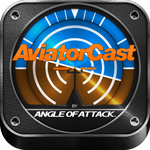
This week, I found myself at an airport just east of Atlanta, GA. I was standing on the ramp, talking to a student pilot, just shy of taking his Private Pilot check ride. He was about to jump in a Cessna 172 for some solo practice when he voiced his concern that the winds were starting to pick up. I actually laughed out loud, only to then feel really bad… I thought he was joking about what I was interpreting as a light breeze. In reality there was a five knot crosswind blowing across the runway.
I’ve always been amazed at how overly complicated people can make crosswind landings seem. While they certainly are one of the more challenging items to master, when it comes to learning to fly, they really aren’t all that complicated.
The Problem
You’ll quickly realize when taking off with a crosswind the aircraft will naturally try to yaw into the wind after the wheels have left the ground. This is perfectly normal and even feels natural after a while. However, we sure can’t land with the aircraft in this alignment. The side-load imposed on the landing gear could cause damage to the gear, evening resulting in a loss of directional control if too much weight is applied too quickly onto the wheels. We’re faced with the problem of having to overcome this.
There are two methods that are commonly taught to cope with this problem:
Solution #1: Crab
Usually the first method taught when it comes to crosswind landings, and the easiest to master. As I mentioned above, the aircraft naturally wants to weather-vane into the wind. We can manipulate the aircraft’s ground track by crabbing more or less into the wind to keep our ground track aligned with the runway, however our heading will usually not be aligned with the runway.
The main benefit of this is comfort for your passengers. Unfortunately though, we can’t allow the aircraft to touch down like this without possibly damaging it.
Solution #2: The Slip
The slip is the more difficult method to grasp. It requires a lot of coordination, but I break it down into two easy steps:
Slipping Made Easy:
- Using rudder, align the nose of the aircraft with the center line of the runway
- Use aileron to correct the aircraft’s drift and align it with the runway’s center-line
(The amount of rudder and aileron pressure required will change as the wind changes! Just keep running through steps 1 & 2 in order each time you need to readjust)
Sounds easy enough, right? With a little practice it is!
The problem with a slip is that it can be uncomfortable for your passengers.
Next week, we’ll take the best of both of these methods and I’ll show you the most common approach for landing when the winds are working against us. I strongly encourage you all to crank up the winds in your sim and experiment with both of these methods. Until then…

Throttle On!
Mathew Young
Cincinnati, OH

![]()
Join the Conversation!
What are some other considerations to take into account with crosswind landings?
This article was posted in AOA, Aviation, Blog, Challenges, Flight Safety, Flight Simulator, Flightsim Tips, Real World
Please note: We reserve the right to delete comments that are snarky, offensive, or off-topic. If in doubt, read the Comments Policy.

